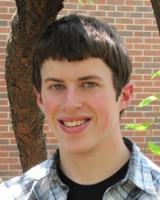2012 REU Program Participant Profiles: Anthony Rhoads
 |
Major: Mathematics |
Why did you apply to the REU program?
I am interested in pursuing a career in math biology, but I wanted to learn more about it first. I knew that this experience would provide me with the perspective I was looking for. It is also a great way to prepare for graduate school, and to learn about what weaknesses I need to focus on during my remaining years as an undergraduate.
What is the purpose of your research?
Our goals are to provide an estimate of the rate of recombination of HIV, and to determine whether the rate is sufficient to explain the relative success of recombinant strains of the virus. We are fitting the recombination data of patients doubly infected with HIV to a simple model, comparing the results to a biologically more detailed model, and then examining the effects of stochasticity on the process. If the patient data cannot be reasonably explained by our models, it would suggest that the recombinant variants have a fitness advantage over the strains of the virus present at the time of initial infection.
![]()
I love the way my project group functions. Coming from different backgrounds with different areas of expertise, we compliment each others’ strengths very well.
![]()
– Anthony Rhoads, REU participant
What does the research ultimately accomplish?
Our results will determine whether recombinant strains of HIV have an inherent fitness advantage over the strains of the virus present at the time of initial infection. In addition, our results will provide an estimate of the rate of virus recombination, which can be used to predict the effects and potential failures of antiretroviral therapy in acute HIV infection.
Describe a typical day on the job:
I usually get to NIMBioS at about 9:00 a.m. Some days start with a lecture or talk, but otherwise I have spent most o f my time so far coding the stochastic simulations for our model, analyzing the results of the simulations, and reading literature related to the problem to learn about the process or find parameters. About twice per week, we meet with our group mentors to talk about the project, receive guidance regarding problems we have, and what to do next. I usually meet with the other students in the group without the mentors once or twice per week, as well.
What were your favorite parts of the REU program?
I love the way my project group functions. Coming from different backgrounds with different areas of expertise, we compliment each others’ strengths very well. Also, our project is easily divisible into three components, so while we often collaborate, each of us can concentrate on one piece of the puzzle, and it is very interesting to see how those pieces fit together to form the bigger picture.
What advice would you give someone who's interested/curious about participating in the program?
It is great if you are already familiar with some type of mathematical software or programming language before you start the program. While learning as you go is a great educational experience, it can also provide many headaches if it is completely new to you. I would recommend asking your mentor if he or she requires you to use anything in particular before the program begins. Looking at or reviewing how to use at least one software package or programming language is probably the best way to prepare for the program.
NIMBioS
1122 Volunteer Blvd., Suite 106
University of Tennessee
Knoxville,
TN 37996-3410
PH: (865) 974-9334
FAX: (865) 974-9461
Contact NIMBioS


